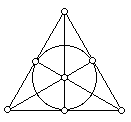Let g be the element g = (x -1)/x and let h be h = 1 - x. Find the orders of g and h in PGL(2, R).
Calculate the elements of the subgroup of PGL(2, R) generated by g and h. What is the group?
[Hint: Show first that one can map [α, 0, 0], [0, β, 0] and [0, 0, γ] to three of the points. Then choose α, β, γ so that [1, 1, 1] is mapped to the fourth point.]
P(V) = V - {0}/~ where ~ is the equivalence relation u ~ v if u = λv for u, v ∈ V - {0} and λ ∈ F.
Let F be a finite field with pk elements where p is a prime number.
Prove that a projective line over F has pk + 1 points on it and that in general if V has dimension n over F, then |P(V)| = (pkn - 1)/(pk - 1).

Deduce that if |F| = 2 and n = 3 we get a projective plane with 7 points.
(The picture on the right represents such a plane. It has 7 points and 7 lines: each point lies on 3 lines and each line contains 3 points. One of the lines is represented by a circle.)
Describe how one could construct projective planes with 13 points and with 21 points.
Solution to question 4

If the vertices of a hexagon lie alternately on two lines, then the meets of opposite sides are collinear.
[Hint: Project two of the meets to points on the line at infinity.]